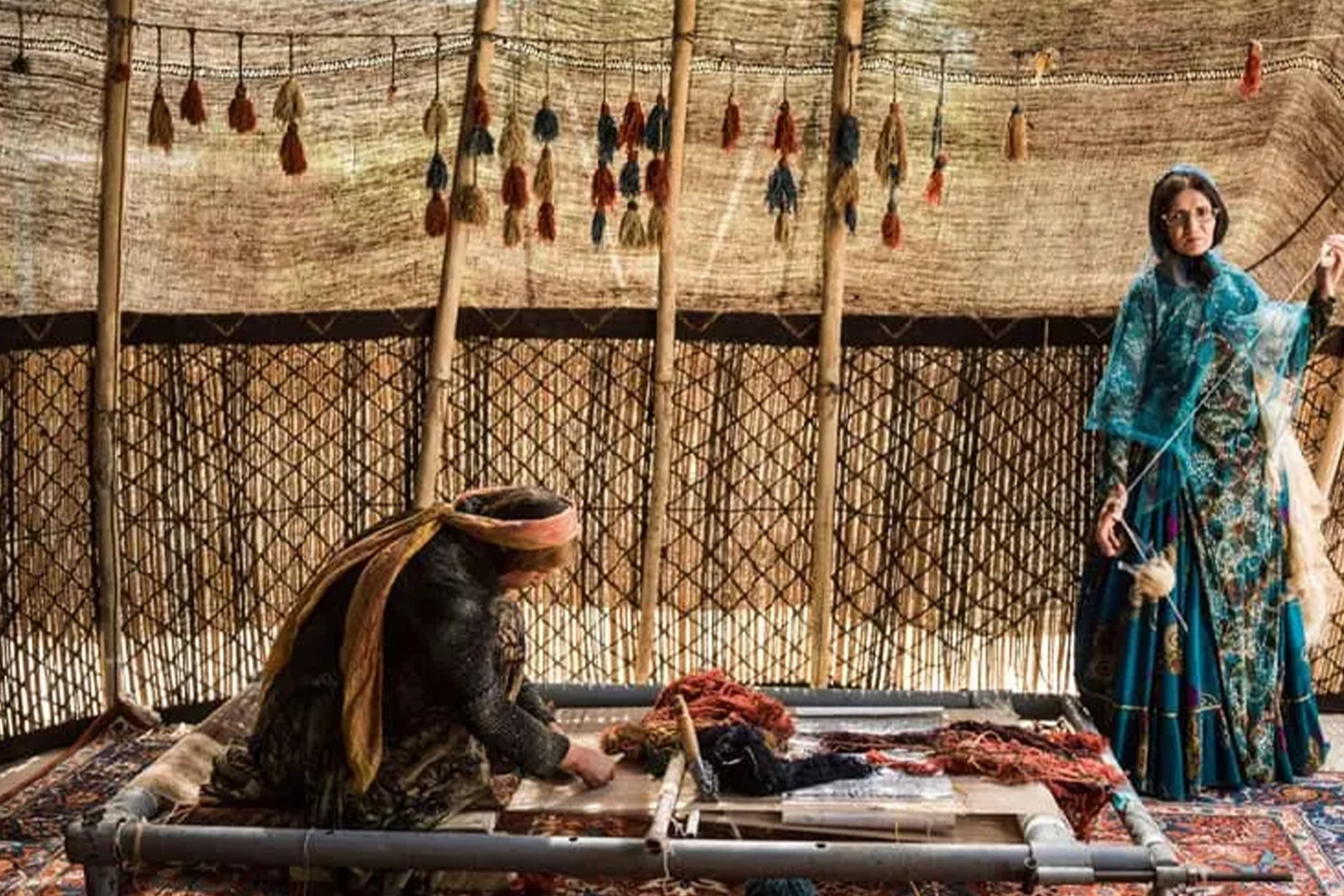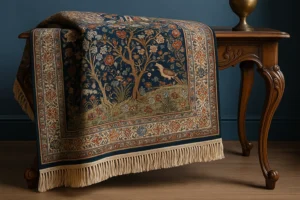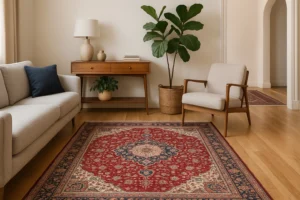The Historical Importance of Persian Carpets
Ancient Persian carpets are among the most significant and treasured handmade artistic and cultural creations of Iran. These carpets are recognized not only as floor coverings but also as works of art and cultural-historical symbols of the Iranian identity. Persian carpets are globally renowned for their intricate designs, beautiful color schemes, and exceptional weaving quality. Here, we highlight some key features and types of these historic carpets.
1. The History of Persian Carpets
Carpet weaving in Iran dates back thousands of years. The oldest known carpet in the world is the Pazyryk Carpet, discovered in 1949 in Siberia. Due to its strong resemblance to Persian designs, many researchers attribute it to ancient Iran. This carpet dates back to the Achaemenid era (circa 500 BCE).
2. Features of Ancient Persian Carpets
- Designs and Motifs: Persian carpets display a wide range of designs, each rich in symbolism and meaning. Some of the most famous motifs include Medallion and Corners (Lachak-o-Toranj), Hunting Scenes, Tree of Life, Floral & Nightingale, and Paisley (Boteh Jeghe).
- Coloring: The dyes used in ancient carpets were usually derived from natural sources like plants, roots, and insects. These natural dyes maintained their vibrancy over time and preserved the carpet’s beauty.
- Materials: Wool, cotton, and silk were the primary materials used. Silk carpets, due to their delicacy and sheen, hold higher artistic and monetary value.
- Knots: Persian carpets are woven using two main types of knots: the Persian (asymmetrical) knot and the Turkish (symmetrical) knot. The Persian knot is more commonly used in central and eastern Iran.
3. Types of Historical Persian Carpets
Persian carpets can be classified based on their region of origin, design style, and weaving techniques. Here are some of the most famous types:
- Tabriz Carpets: Tabriz is one of the most important carpet-weaving centers in Iran. Tabriz carpets are known for their wide variety of patterns and the use of vibrant and joyful colors.
- Isfahan Carpets: These carpets are among the most luxurious and expensive Persian rugs, admired for their elegance and fine craftsmanship. Common features include silk materials, delicate designs, and the popular medallion and corner layout.
- Kashan Carpets: Kashan is another renowned carpet-producing city. Kashan rugs often feature classical Persian motifs and natural dyes, making them highly valued.
- Kerman Carpets: Known for floral motifs and soft, harmonious color palettes, Kerman carpets are widely loved for their beauty and durability.
- Qom Carpets: Usually made entirely of silk, Qom rugs are considered luxury items due to their precision, brightness, and spiritual themes.
- Bakhtiari Carpets: Woven by the Bakhtiari nomads, these rugs feature bold geometric patterns and vibrant colors.
- Turkmen Carpets: Recognized for their geometric shapes and red-brown color schemes, Turkmen rugs are mostly made by nomadic tribes in northeastern Iran.
4. Famous Persian Carpets in Museums Around the World
- The Ardabil Carpet: Woven in the 16th century, this masterpiece is one of the most famous Persian carpets, currently housed in the Victoria and Albert Museum in London.
- The Hunting Carpet: Another prized example, this rug showcases hunting scenes and is displayed in institutions like the Metropolitan Museum of Art in New York.
5. Cultural and Economic Significance
Persian carpets have not only served as artistic treasures but also as valuable economic assets. Iranian rug exports have historically played a significant role in the country’s economy. Moreover, carpet weaving as a traditional art form has helped preserve Iranian cultural identity and artistic heritage.
6. Preservation and Conservation
Due to the historical and cultural value of ancient Persian carpets, preserving these artifacts is of utmost importance. Many antique rugs are kept in museums and private collections to protect them from damage caused by time, light, moisture, and environmental factors. Conservation efforts include climate-controlled storage, limited exposure to sunlight, and specialized cleaning techniques.
Ancient Masterpieces of Persian Carpet Art
Ancient Persian carpets not only reflect Iran’s rich artistic heritage but also stand as historical documents of its cultural and technical achievements. Below are some of the most renowned examples:
1. Pazyryk Carpet
Age: Approximately 2,500 years (Achaemenid Empire)
Discovery Location: Pazyryk Valley, Siberia (Russia)
Features: Considered the oldest known hand-woven carpet in the world. Its patterns include animal motifs, floral designs, and geometric shapes. Made of wool and dyed with natural pigments.
Significance: Demonstrates the high skill level of ancient Iranian weavers and confirms Iran’s deep historical connection to carpet weaving.
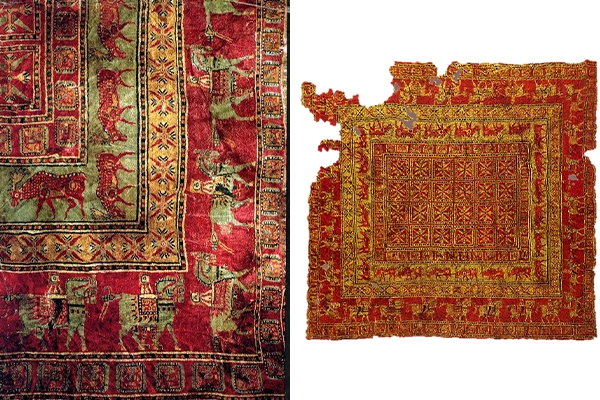
2. Baharestan Carpet (Khosrow Carpet)
- Age: Sassanid period (~1,500 years ago)
- Features: A legendary carpet that once adorned the palace of the Sassanid kings in Ctesiphon. Known as one of the artistic wonders of the ancient world. Its design represented a royal garden with blooming flowers and fruit trees, woven with silk, gold, and silver threads.
- Significance: A symbol of the grandeur and sophistication of Persian culture and art during the Sassanid era.
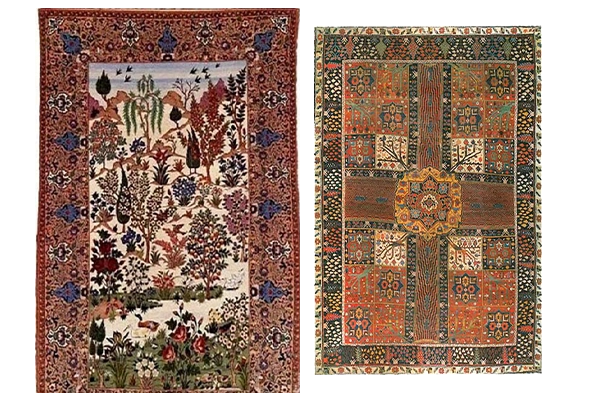
3. Safavid Dynasty Carpets
- Age: 16th to 18th centuries CE
- Features: The Safavid era marked the golden age of Persian carpet weaving. Rugs from this time are noted for their intricate patterns, natural dyes, and luxurious materials like silk and fine wool. Common themes include floral arrangements, animals, and hunting scenes.
- Famous Examples: The Ardabil Carpet (Victoria and Albert Museum, London), Chelsea Carpet (Metropolitan Museum, New York).
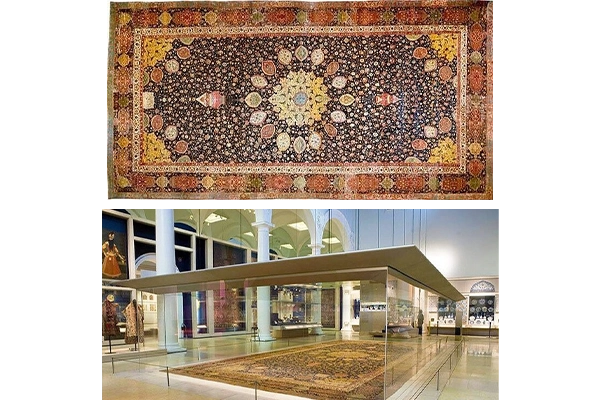
4. Qajar Period Carpets
- Age: 19th century CE
- Features: Carpets of the Qajar era featured diverse patterns and vivid colors. Themes often included floral and bird motifs, royal portraits, and historical scenes.
- Significance: These rugs gained popularity in global markets for their artistic richness and unique narrative styles.
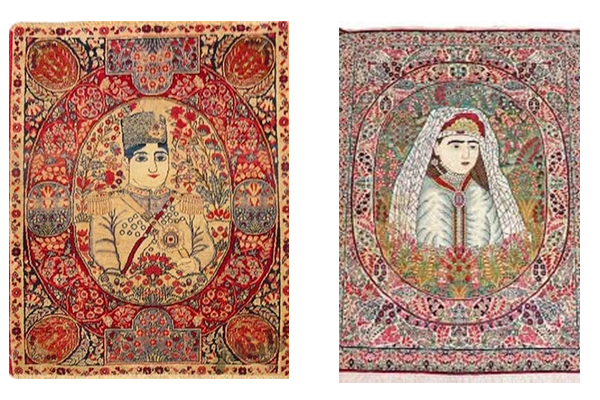
5. Regional Styles of Persian Carpets
Persian carpets are distinguished not only by their designs but also by their places of origin. Each region brings its own artistic flair, motifs, and weaving techniques.
- Tabriz Carpets
Known for their intricate medallion (Lachak-Toranj) designs and wide color variety, Tabriz carpets often feature fine knotting and are among the most collectible Persian rugs. - Isfahan Carpets
These are highly refined carpets woven with silk and wool, known for their symmetrical designs, central medallions, and elegant floral patterns. They often use a palette of ivory, navy, and red. - Kerman Carpets
Characterized by soft, coordinated colors and floral motifs, Kerman carpets are celebrated for their elegance and gentle aesthetic. - Qom Carpets
Typically woven from pure silk, Qom rugs are prized for their high knot density and exquisite detail. Designs often include religious and traditional motifs. - Bakhtiari Carpets
Woven by the Bakhtiari nomads, these rugs are known for their bold geometric patterns and vibrant colors. - Turkmen Carpets
Made by Turkmen tribes, these rugs showcase geometric motifs in deep reds and browns, reflecting tribal identity and traditions.
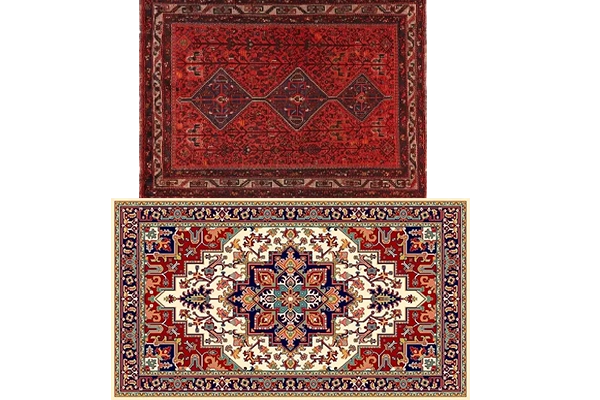
6. Dyeing and Raw Materials
- Natural Dyeing
Ancient Persian carpets were colored using natural dyes extracted from madder root, indigo, walnut husk, and pomegranate peel. These organic dyes gave the carpets long-lasting vibrancy and depth. - Materials
High-quality sheep wool, pure silk, and cotton formed the primary materials of traditional Persian rugs. The use of silk, in particular, added a touch of luxury and finesse.
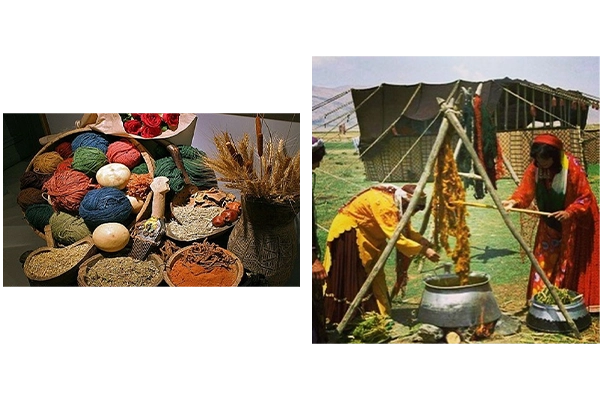
7. Global Recognition and Importance
Persian carpets have long been admired in global markets for their artistic merit, craftsmanship, and cultural authenticity. Many world-renowned museums—including the Louvre, the Metropolitan Museum of Art, and the Victoria and Albert Museum—feature Persian carpets in their permanent collections.
These ancient rugs not only serve as practical floor coverings but also as timeless cultural symbols, showcasing the ingenuity, patience, and soul of the Iranian people.
